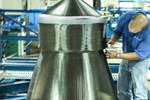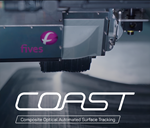API Metrology streamlines aerospace manufacturing with Dynamic 9D LADAR
Mounted onto an autonomous guided vehicle (AGV), the inspection system enables quick, precise and noncontact data collection for aerospace parts, including those made with composites.
Photo Credit: API Metrology
(API Metrology, Rockville, Md., U.S.), a global dimensional metrology solutions provider, announces a novel approach to aerospace manufacturing inspections with its Dynamic 9D LADAR (laser detection and ranging) mounted on an autonomous guided vehicle (AGV). The company confirms its applicability for the inspection of fiber-reinforced composite parts and structures.
is a fast, noncontact measurement system that automates data collection. When integrated with an AGV, the 9D LADAR system offers flexibility and coverage across the manufacturing floor, navigating autonomously and adjusting its measurement height as needed. With a 25-m range and a scanning speed of 0.2 sec/cm², the solution precisely captures dimensional and surface geometry data. It maintains 3D accuracy of 25 μm + 6 μm/m (2 sigma).
Joe Bioty, president of API, says the system streamlines aerospace operations, enhancing productivity and efficiency. For example, it eliminates manual inspections, reducing potential human errors and enabling skilled workers to focus on more intricate tasks. The system can also be integrated into existing manufacturing processes and is compatible with third-party metrology software.
Related Content
-
First Airbus A350 crash confirmed in Haneda
Shortly after touch-down, a JAL A350-900 aircraft recently collided with a De Havilland Canada Dash 8. Exact circumstances are still unknown.
-
The potential for thermoplastic composite nacelles
Collins Aerospace draws on global team, decades of experience to demonstrate large, curved AFP and welded structures for the next generation of aircraft.
-
The next-generation single-aisle: Implications for the composites industry
While the world continues to wait for new single-aisle program announcements from Airbus and Boeing, it’s clear composites will play a role in their fabrication. But in what ways, and what capacity?



